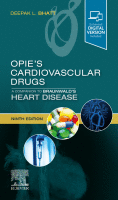Physical Address
304 North Cardinal St.
Dorchester Center, MA 02124

Drug Class Overview and Guidelines Pulmonary arterial hypertension (PAH) is a rare, heterogenous family of disease states marked by pathologic remodeling of the pulmonary vascular system, leading to increased pulmonary artery pressure and ultimately right ventricular failure, hypoxia, and death.…

Overview Drugs for Patients With Peripheral Artery Disease Peripheral artery disease (PAD) is broadly defined as arterial occlusive disease outside of the coronary circulation and generally refers to atherosclerotic occlusive disease. While nonatherosclerotic occlusive disease including that related to fibromuscular…

Overview of New Developments Antiarrhythmic drugs have not changed substantially over the last several decades. Even when newer agents have been developed, the potential for proarrhythmia and increased mortality continue to plague their broader implementation. Recently, novel ion channel targets…

Introduction Antithrombotic therapy represents a time-tested foundation for the prevention and treatment of cardiovascular disease that is firmly rooted in an understanding of the pathophysiology of common clinical phenotypes, including acute coronary syndrome, acute ischemic stroke, venous thromboembolic disease, stent…

You’re Reading a Preview Become a Clinical Tree membership for Full access and enjoy Unlimited articles Become membership If you are a member. Log in here

Serum cholesterol level is known to be related to incident atherosclerotic cardiovascular disease (ASCVD), with low-density lipoprotein cholesterol (LDL-C) found to be a dominant contributor to atherosclerosis. Multiple large landmark randomized controlled trials of lipid-lowering therapy have consistently shown that…

Drug Class Overview and Guidelines Obesity is a worldwide societal and medical problem. The most recent estimates (2017) suggest that more than 1.9 billion people in the world are overweight (body mass index [BMI] 25–29 kg/m 2 ) and over…

Metabolic Syndrome and Prediabetes Obesity has become a common problem in Western society, and it is a strong predictor of type 2 diabetes mellitus (T2DM). In the United States it is estimated that almost one-third of the population will develop…

Introduction Drug therapies for heart failure (HF) differ depending on the phenotype of presentation. Distinctive phenotypes of presentation have different management targets, ranging from acute decompensated HF (ADHF) to chronic HF with reduced ejection fraction (HFrEF) or preserved ejection fraction…

Introduction The formal classification and blood pressure (BP) threshold to define an individual as having hypertension continues to vary based on available evidence. The appraisal of such evidence by professional associations and societies has led to different BP thresholds adopted…